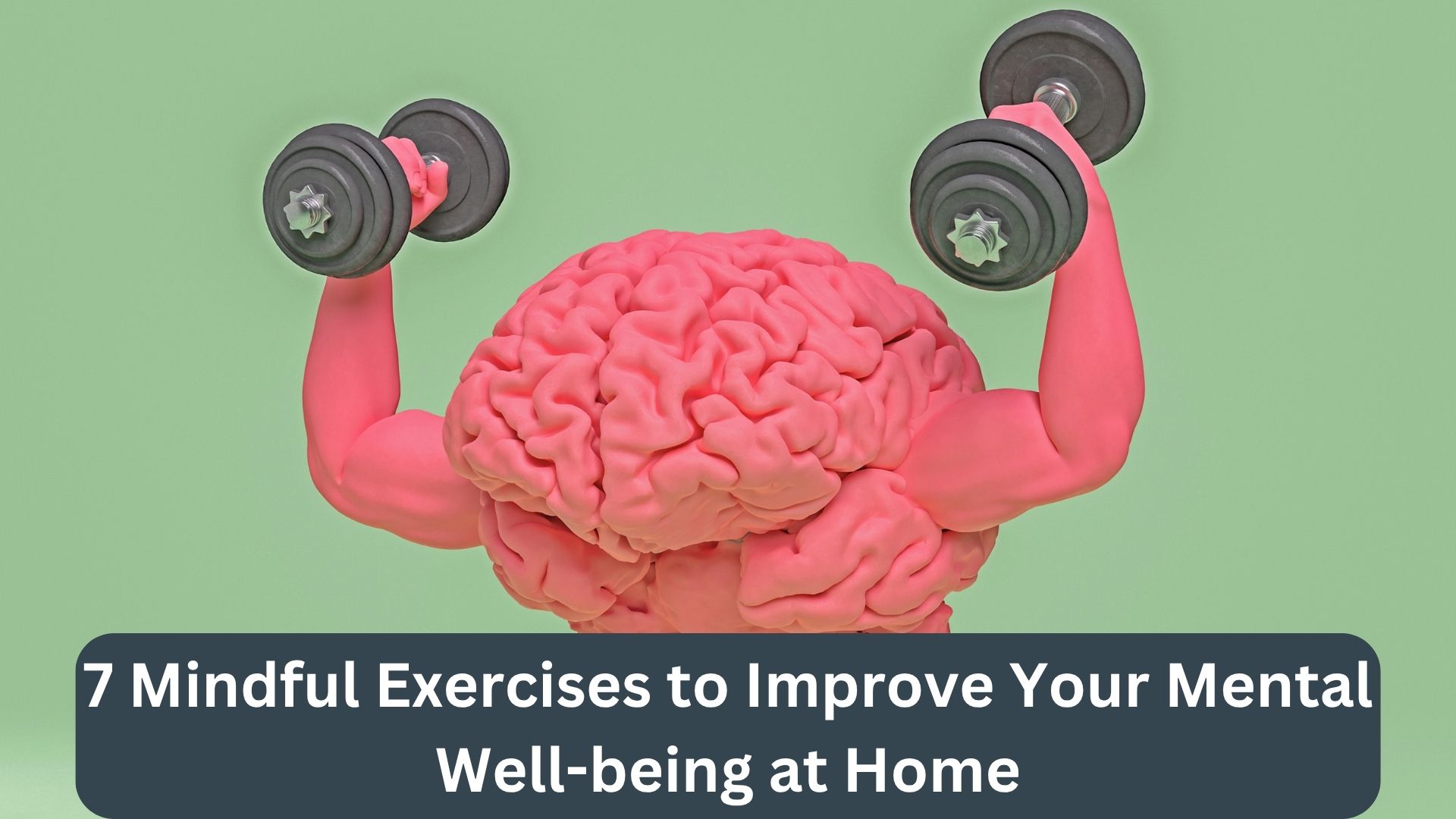In today’s fast-paced, hyper-connected world, carving out time for mindfulness and mental wellness is no longer a luxury—it’s a necessity. Fortunately, you don’t need a fancy yoga studio, expensive equipment, or even a gym membership to start improving your mental well-being. The comfort of your own home can be the perfect sanctuary for cultivating peace, presence, and inner strength.
In this guide, we’ll explore 7 powerful and practical mindfulness exercises you can do from home to reduce stress, boost emotional resilience, and enhance your overall mental clarity. These techniques are simple, scientifically backed, and require little to no prior experience. Let’s dive in.
1. Deep Breathing (Diaphragmatic Breathing)
Why It Works:
Breathing is the most accessible tool we have to instantly shift from a state of stress (sympathetic nervous system) to calm (parasympathetic nervous system). Diaphragmatic breathing lowers cortisol levels, slows your heart rate, and relaxes your muscles.
How to Practice:
| Step | Action |
|---|---|
| 1 | Sit comfortably or lie down. Close your eyes. |
| 2 | Inhale deeply through your nose for 4 seconds, expanding your belly. |
| 3 | Hold your breath for 4 seconds. |
| 4 | Exhale slowly through your mouth for 6–8 seconds. |
| 5 | Repeat for 5–10 minutes. |
Tips:
- Place one hand on your belly and one on your chest. Make sure only your belly rises and falls.
- Practice in the morning to center yourself or before bed to promote deep sleep.
2. Mindful Journaling
Why It Works:
Journaling clears mental clutter and provides a safe outlet for emotional expression. It can reveal unconscious patterns and help you reframe negative thoughts.
Journaling Prompts:
- What thoughts or emotions am I experiencing right now?
- What am I grateful for today?
- What am I trying to control that I need to release?
Sample Weekly Journal Format:
| Day | Prompt | Insight |
|---|---|---|
| Monday | What made me smile today? | [Write reflection] |
| Wednesday | What am I learning about myself? | [Write reflection] |
| Friday | What will I let go of before the weekend? | [Write reflection] |
Bonus Tip:
Pair journaling with a calming tea ritual or soft music to create a mindful atmosphere.
3. Grounding Through Body Scan Meditation
Why It Works:
A body scan helps reconnect you with your physical self, especially when anxiety or overthinking pulls you into your head. This practice increases interoceptive awareness, helping you notice tension and release it consciously.
How to Do a Body Scan:
- Lie flat on your back or sit in a relaxed position.
- Close your eyes and bring your attention to your feet.
- Slowly “scan” up your body—feet, calves, knees, thighs, hips, stomach, chest, arms, neck, and head.
- As you notice each area, consciously relax that part of your body.
- If your mind wanders, gently return to the body.
| Duration | Frequency | Best Time |
|---|---|---|
| 10–20 minutes | 3–5 times/week | Evening or after work |
4. Nature Visualization and Sound Meditation
Even if you’re indoors, you can tap into the calming power of nature with guided imagery and ambient sounds.
How to Practice:
- Close your eyes and imagine a peaceful natural setting—like a forest, beach, or garden.
- Use apps like Insight Timer or Calm for realistic soundscapes.
- Focus on sensory details: the breeze on your skin, birds chirping, waves crashing.
Guided Visualization Script (Sample):
“You’re walking through a lush forest. Sunlight filters through the leaves. With each step, you feel more grounded, more calm…”
Suggested Duration:
10 minutes in the morning or during midday stress breaks.
| Tools | Free Resources |
|---|---|
| Headphones | YouTube (Search “nature meditation 10 minutes”) |
| Eye mask (optional) | Insight Timer App |
| Quiet corner | Spotify – Nature Soundscapes Playlist |
5. Mindful Cleaning
Yes, cleaning can be a mental wellness tool—when done with intention.
Why It Works:
Cleaning provides sensory input, immediate visual feedback, and a sense of control. When done mindfully, it becomes a moving meditation.
Practice Tips:
- Focus on one task at a time (e.g., washing dishes, folding clothes).
- Notice textures, temperatures, and smells.
- Breathe slowly and deeply as you work.
- Let go of multitasking—just be with the task.
Try This:
Put on calming music, light a candle, and turn your 15-minute cleanup into a ritual of clarity.
| Activity | Mindful Intention |
|---|---|
| Washing dishes | “I am cleansing, not just plates but my mind.” |
| Sweeping floor | “With each sweep, I remove old energy.” |
| Making bed | “I create a fresh space to begin again.” |
6. Gratitude & Intention Setting
Why It Works:
Gratitude rewires the brain to focus on abundance instead of lack, which reduces stress and depression. Setting daily intentions gives you purpose and direction.
Simple Daily Practice:
Morning
- Write down 3 things you’re grateful for.
- Set 1 intention for the day (e.g., “Today I choose patience.”)
Evening
- Reflect on the best moment of your day.
- Write down something you did well.
Example Table:
| Time of Day | Gratitude | Intention |
|---|---|---|
| Morning | My cozy home, morning coffee, supportive friend | “Be kind to myself.” |
| Evening | Productive day, heard a favorite song, took a walk | “I honored my need for rest.” |
Tools You Can Use:
- A blank notebook
- Google Docs with daily templates
- Free gratitude apps like “Presently” or “Grateful”
7. Movement Meditation (Yoga, Tai Chi, or Walking)
Movement doesn’t always need to be intense to be effective. Gentle, mindful movement brings awareness to the body, synchronizes breath, and fosters a peaceful mind.
3 Options to Try at Home:
| Type | Description | Recommended For |
|---|---|---|
| Yoga | Stretching, balance, deep breathing | Tension, anxiety, low energy |
| Tai Chi | Slow, flowing movements | Stress, chronic pain, focus |
| Mindful Walking | Walking slowly, observing sensations | Clarity, emotional release |
How to Practice Mindful Walking:
- Step outside or pace indoors.
- Walk slowly and silently.
- Focus on the feel of your feet touching the ground.
- Observe your surroundings without judgment.
Video Resources:
- YouTube Channels: Yoga with Adriene, Dr. Paul Lam (Tai Chi), Jon Kabat-Zinn (Mindfulness)
- Apps: Down Dog, Simply Yoga, Daily Yoga
How to Make Your Home a Mindfulness Haven
Creating a Dedicated Space:
- Choose a quiet corner or window seat.
- Add soft cushions, blankets, and calming scents.
- Keep a journal, candle, or plant nearby to build a ritual.
| Element | Suggestions |
|---|---|
| Lighting | Warm, dim lighting or natural daylight |
| Scents | Lavender, eucalyptus, sandalwood essential oils |
| Objects | Incense holder, mindful quotes, singing bowl |
Daily Flow Example:
| Time | Practice |
|---|---|
| 7:00 AM | Deep Breathing & Gratitude Journal |
| 12:00 PM | Nature Visualization (10 mins) |
| 5:00 PM | Yoga or Walking Meditation |
| 9:00 PM | Body Scan & Reflective Journaling |
The Science Behind Mindfulness
Scientific studies continue to confirm the positive effects of mindfulness on mental health.
| Benefit | Backed by Research |
|---|---|
| Reduced stress & anxiety | Harvard and Stanford studies show mindfulness reduces cortisol |
| Improved focus | MRI studies show thicker prefrontal cortex in meditators |
| Better emotional regulation | Mindfulness activates areas related to empathy and emotion control |
| Improved sleep | Mindful breathing lowers heart rate and calms the mind before bed |
Final Thoughts: Small Practices, Big Shifts
You don’t need hours of free time or a wellness retreat to take care of your mental health. Even five minutes of intentional practice each day can begin to shift your mindset and emotional state.
Remember, mindfulness is not about perfection—it’s about showing up. It’s about noticing your breath while you fold the laundry. It’s about choosing stillness even when life is noisy. It’s about coming home to yourself, again and again.
Start with one or two exercises from this list, and slowly build your own toolkit of calming rituals. In time, your home will not just be where you live—it will be where you heal.
Summary Table for Easy Reference:
| Mindful Exercise | Best Time to Practice | Duration |
|---|---|---|
| Deep Breathing | Morning / Bedtime | 5–10 mins |
| Journaling | Morning & Evening | 5–15 mins |
| Body Scan | Before sleep | 10–20 mins |
| Visualization | Breaks / Afternoon | 10 mins |
| Mindful Cleaning | Daily chores | 15–30 mins |
| Gratitude & Intention | Daily | 5 mins |
| Movement Meditation | Anytime | 10–30 mins |
Your Next Step
Try picking just one of these exercises today. Set a reminder on your phone, find a quiet space, and give your mind the gift of mindful attention.
And if you’d like more practical tips like these, follow me at febylunag.com for weekly mindfulness check-ins, productivity guides, and self-care rituals—designed for the busy, modern human trying to keep their peace.
You deserve to feel well. Start at home. Start now.







Leave a Reply